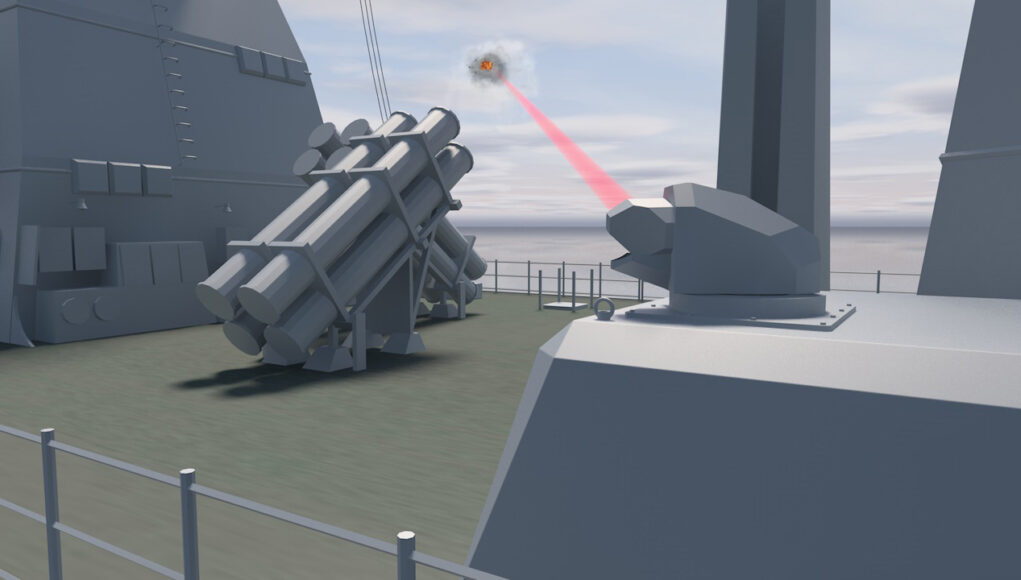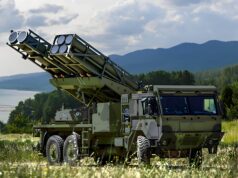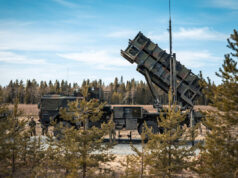Germany has awarded a consortium consisting of MBDA Deutschland and Rheinmetall a contract to fabricate, integrate and support testing of a laser weapon demonstrator in the maritime environment.
MBDA Deutschland say they will be responsible for tracking, the operator’s console and linking the laser weapon demonstrator to the command-and-control system.
Rheinmetall is in charge of the laser weapon station, the beam guiding system, cooling, and integration of the laser weapon system into the project container of the laser source demonstrator.
The demonstrator is to be fabricated, tested and integrated by the end of the 2021. Trials onboard the German Navy frigate F124 Sachsen are to take place in 2022.
As Doris Laarmann, head of laser business development at MBDA Deutschland, said:
“The contract is an important step on the path to an operational high-energy laser system. Our two companies will apply their respective strengths to make this project a success on behalf of the German Navy. Once it’s installed, the demonstrator will also be used to test important aspects such as the interaction and function of the sensor suite, combat management system and effector as well as rules of engagement.”
Alexander Graf, head of Rheinmetall Waffe Munition’s laser weapons programme, said:
“The contract marks a systematic extension of the functional prototype laser weapon successfully tested in recent years, with the experience gained now dovetailing into one of the most ambitious projects in the field of laser weapon development in Europe.”












Ha, looks like I’m ze furst to comment….
Fair play, its looking like the way ahead, maybe not now or in 5 years time so good for them for jumping on the bandwagon.
Morning Andy. Lasers in fiction have been around since the days of ‘Dan Dare’ and time before but never actually seem to get anywhere in reality. Given the pace of tech advance these days one would expect the development of one that actually works to the extent of coming into service soon, but it seems that Laser weapons are stuck along with nuclear fusion,endless power from water and other such elusive endeavours. Can anyone here explain to guys like me what the problems are and how likely is it that we will actually develop real ones anytime soon?
Regards
I have highlighted the issues a number of times in previous posts.
There are some excellent papers on the issues provided to the US Congress by their own independent research group. They provide details on the issues , projected timelines for deployment and capability.
In short current lasers are good for slow low UAVs and small boats out to around 2-3 km.(as long as its a clear day, not raining, foggy and no air pollution is around)
For “Star Wars Turbo laser” shooting down ballistic missiles you will need a free electron laser, a ship the size of an LPD to be dedicated to carry it and a shed load of CERN type, Tefal headed, particle physicists permanently on a ship to keep it working. All of which I am sure is thoroughly practicable!
Link on the latest report
https://crsreports.congress.gov/product/pdf/R/R44175
Thanks Gunbuster
Thanks for that. Hadn’t heard about FELs before. Just did a quick look up and found this on Wikipedia “FEL technology is being evaluated by the US Navy as a candidate for an antiaircraft and anti-missile directed-energy weapon. The Thomas Jefferson National Accelerator Facility‘s FEL has demonstrated over 14 kW power output.[36] Compact multi-megawatt class FEL weapons are undergoing research.[37] On June 9, 2009 the Office of Naval Research announced it had awarded Raytheon a contract to develop a 100 kW experimental FEL.[38] On March 18, 2010 Boeing Directed Energy Systems announced the completion of an initial design for U.S. Naval use.[39] A prototype FEL system was demonstrated, with a full-power prototype scheduled by 2018.[40]“
Hi Gunbuster
Darth Vader got the Death Star to work in the mid 70’s
May the force be with you……
The problem with reports from the CRS is that the analysts do not have access to classified US DOD information and, certainly, not compartmented information. Their reports are fine for open source material but do not expect them to be aware of classified or compartmented programs/information. The successful theft of reams of technical information by the Chinese has seen a large swath of sensitive US DOD programs become either classified or restricted access. The Pentagon will brief select Congressional staffers for the appropriate Armed Services or Appropriations Committee but those briefings are closed door with no dissemination to the CRS.
With many things Classification restricts what you can discuss in an open forum. I still have to stop think and check what I type before I press post just in case some of the info is sensitive.
What is good about CRS is that someone has done the trawling of open sources first and placed it together in reports. The cost of a Standard 6 for instance was difficult/impossible to find however someone at CRS calculated it via procurement documents.
i doubt the RN will be buying at that price!
The problem with the CRS is its analysts just aren’t defense professionals and, more importantly, just don’t have the contacts within the US defense establishment and the clearances to get access to what is going on in that world. And more and more is being put behind classification and compartment walls. The manner in which the US Air Force built and flew a sixth generation fighter is typical of what’s going on. To say that it took everyone by surprise is putting it mildly.
The SM-6 may be costly but it provides the US Navy with a ballistic missile defense, something the RN lacks. With the development of the Chinese DF-26 and DF-21 such a defense is crucial.
Just to add that natural hydrogen/oxygen release from water, due no doubt to the enforced demise of ICE propulsion, seems to be starting finally to be a practical reality with the exploitation of nano technology. Just as with batteries a lot of these technologies sit there endlessly and unloved just as fuel cells did until the moon programme gave it impetus, simply because without massive investment induced by something transformational they will never reach their potential to compete or very often out compete with existing technology which may be inferior on occasion but has that ongoing systematic investment being the profitable established well understood product.
The US Navy has an operational laser named HELIOS, 60kw, designed to be used against drones at sea. Arleigh Burke Flight IIa destroyers will start to be fitted with them starting later this calendar year.
Yes they do. It’s a dazzler and offensive laser system with a range of around 2 km on a good day against a low slow drones.
The reason for them is cost.
Nobody, not the US or its allies, wants to shoot a 4.5 mil dollar Standard 6 or a 3 Mil Patriot missile at a 1000 dollar quad copter drone.(as someone in the Gulf did last year. That wasn’t a cost effective use of military resources!!! )
It does what it is designed to do. A low cost defense against slow drones integrated into the Aegis system By the time the Germans get around to building and testing their “demonstrator” (which the Bundestag will probably prevent them for ever deploying), the US Navy will be on a third generation of HELIOS.
Meanwhile, relative radio silence from the UK program. I hear they’ve hit a number of delays. Though it could be our goals are more ambitious.
Indeed over a year now from when they were supposed to be testing a demonstration version and I can’t find any news on it at all in that time.